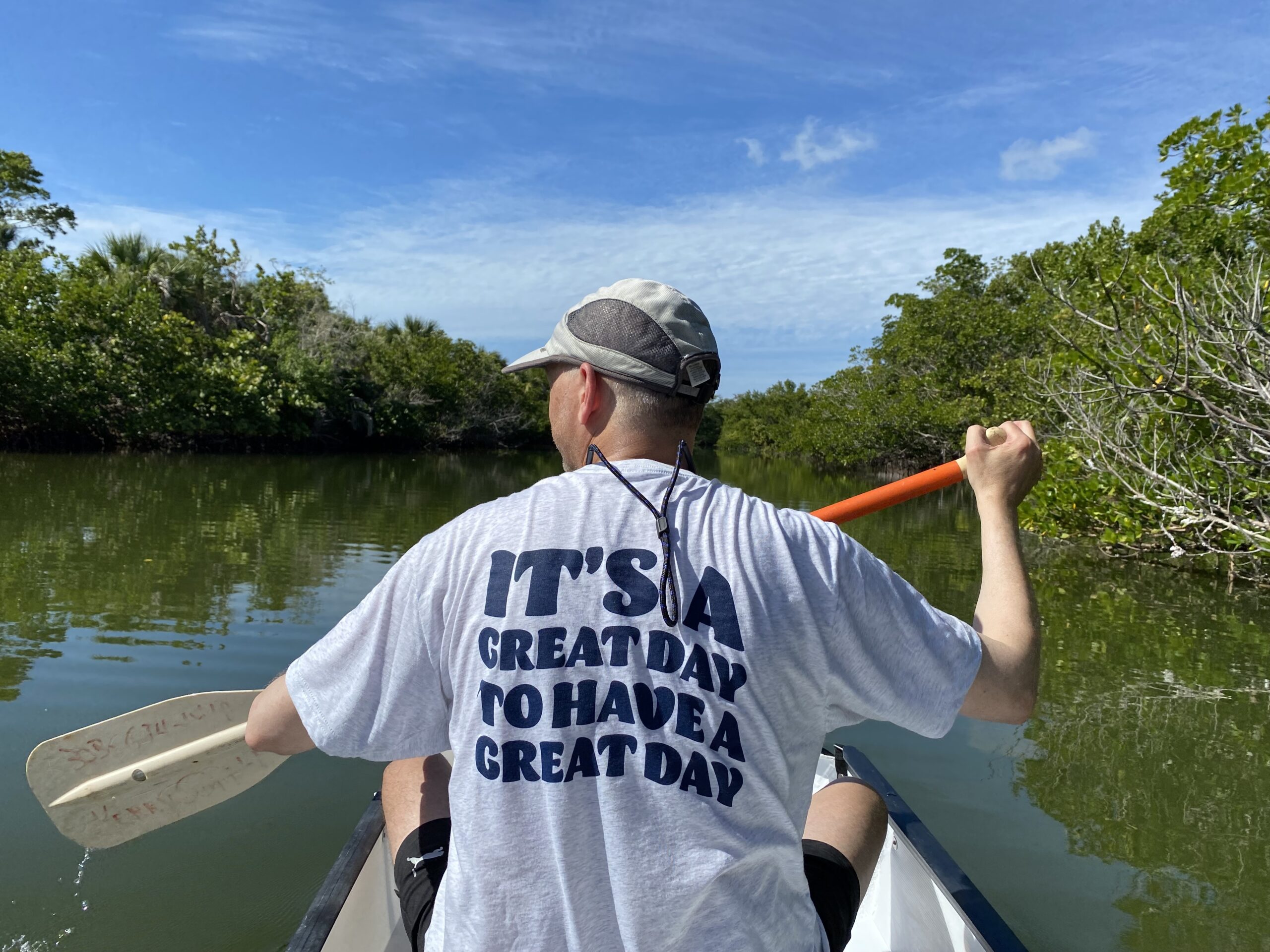We’re not really beach people. Mrs. 123 doesn’t do well in the sun all day, and I don’t know what to do with myself for hours on end sitting on the sand. So when we arrived in the Naples area, hitting the beach wasn’t a top priority. (I had misidentified Venice as Naples in my last post. Sorry about that confusion.)
We prefer more active days and time spent in nature, so we made our way to Clam Pass Park in north Naples. The park provides access to a gorgeous beach, but first you must walk (or get shuttled on a golf cart) a half-mile along a boardwalk through a mangrove forest. The boardwalk offers informative signs helping you to distinguish between the different type of mangroves, birds and other creatures found in the park. A spider conveniently anchored its web to the sign describing the local spiders. As nearly everywhere in Florida, we saw plenty of wading birds along the way.
The boardwalk ends at a beautiful beach that is supposed to be a prime shelling location. We walked a half mile up the beach, and even dipped a toe in the water. It was too cold for swimming.

From Clam Pass, we drove north to the Fort Myers Beach area, to Lovers Key State Park. The park includes a set of barrier islands only reachable by boat, but also offers paddling in canals through mangrove forests. We set up our collapsible canoe, this time following the proper instructions. There’s a 2.5-mile canoeing trail at the park, but we didn’t hit the right canal. So we mostly spent two hours paddling into dead ends. Many of the tree branches closer to the water had barnacles growing on them, a sign that water levels can rise significantly here.
On our way back to our campground, we drove into downtown Naples, along Fifth Avenue, home to upscale fashion and jewelry boutiques, fancy restaurants and other establishments well out of our price range. We drove the surrounding streets checking out the luxury real estate.

The next morning we set off for Big Cypress National Preserve, a protected wilderness area just north of the Everglades. We had hiked in Big Cypress about 20 years earlier. We had foolishly started that hike in hiking boots, and after the second water crossing, decided to do the rest in sport sandals.

On this visit, we didn’t have time for a long hike but instead drove the 27-mile loop road. The road starts off unpaved and pretty rough, but generally gets smoother along the way to the paved final eight miles. We saw many large birds feeding by the road and a few gators warming themselves in the sun.
We had grand plans the next day for Sanibel Island, but learned that much of the island is still recovering from Hurricane Ian last year. The island’s landmark iron skeleton lighthouse, which dates back to 1884, had lost one of its legs in the storm, and access to the area was limited. Sanibel Island has a great seashell museum, but it too was still closed for repairs.
Fortunately, the J.N. “Ding” Darling National Wildlife Refuge was open. Most visitors drive a four-mile wildlife road in the car. We opted to get some exercise and hike the Indigo Trail two miles to where it connects with the wildlife drive, and then hike back along the road.
The refuge is much more of a swamp than Everglades or Big Cypress, and you could smell the difference. We saw very little wildlife along the trail other than a large green and orange iguana in a far-off tree, a few birds and a gator. There were more birds in the open waters along the road on our way back, including a handful of pink Roseate Spoonbills.

The refuge also boast what apparently was voted America’s best bathrooms. They’re covered in educational material about the wildlife in the park. I snapped a photo while the bathroom was empty, because who wants to be the guy taking pictures while others are using the bathroom?
After a picnic lunch inside our car – the weather was a bit cool and windy – we drove north, over the bridge to Captiva Island. Even more than Sanibel, Captiva seemed to be nothing but beach rentals.

On our final day in the area, we visited the Audubon Society’s Corkscrew Swamp Sanctuary. This nature preserve showcases the Everglades ecosystem with a 2.25-mile boardwalk loop through a wilderness that includes the largest old-growth bald cypress forest on the continent.
It’s a birder’s paradise and early on a woman waved me over excitedly.
“We just saw an American bittern!” she exclaimed.
“Is that a bird?” I asked.
She looked at me with complete disdain. “Yeah, I guess it’s just a bird.”
I tried to explain that I wasn’t a birder, but the woman seemed completely exasperated with me.
“You won’t see him,” she told me. “He’s very well hidden.”
Despite being shamed by the birder, we continued along the boardwalk, spying a couple of different species of woodpeckers and then happening upon a family of five baby raccoons in a tree eating berries. I don’t want to sound like city folk, but it’s the first I’ve seen raccoons doing anything other than pillaging garbage. For just a brief minute, we saw an alligator in the water alongside the boardwalk before it submerged out of sight.
The boardwalk is a wonderful way to get a close-up view of terrain that would otherwise be exceedingly difficult to traverse. If you’re in the area, you should go; even if you don’t know what a bittern is.
Days: 23
Miles traveled: 3597
Next stop: The Florida Keys


